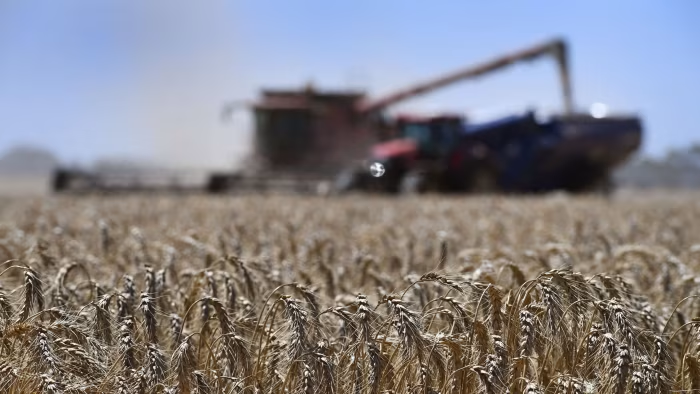The Taliban government has confirmed that it attacked Pakistani troops in multiple mountainous locations on the northern border.
Casualties are not yet clear in what the Taliban called “retaliatory operations”, after it said Pakistan violated…

The Taliban government has confirmed that it attacked Pakistani troops in multiple mountainous locations on the northern border.
Casualties are not yet clear in what the Taliban called “retaliatory operations”, after it said Pakistan violated…

Unlock the Editor’s Digest for free
Roula Khalaf, Editor of the FT, selects her favourite stories in this weekly newsletter.
Charlie Baldry, a fifth-generation wheat farmer outside Cootamundra in rural New South Wales, kicked a patch of waxy weeds that, left unchecked, could wipe out his crop.
“If it gets away from you, it can wipe out a whole paddock,” he said. “It’s public enemy number one.”
Wimmera Ryegrass is a scourge for Australian wheat farmers. The red-stemmed grass, introduced in the 1880s as grazing fodder, has since spread to more than 8mn hectares of grain crops across the country. It now costs farmers about A$93mn (US$61mn) a year in lost revenue, according to the Grains Research and Development Corp.
It is also among the most resistant to herbicides, according to scientists, with farmers and agribusiness racing to find new chemicals to fight the weed that threatens one of the country’s most important export crops.
That effort has taken on added urgency. Canberra is set to rule by the end of the year on the use of the pesticide paraquat, which is already banned in many countries due to health and environmental concerns. Global opposition to other herbicides such as Bayer’s glyphosate has also grown, including from US health secretary Robert F Kennedy Jr.
Jack Hogan, an agronomist who works near Cootamundra, said restrictions on paraquat would make life much harder for farmers already struggling with weed resistance.
“If the paddocks are already resistant . . . the paraquat review presents a major challenge,” he said. “It’s pretty scary.”
The Australian Pesticides and Veterinary Medicines Authority, a regulator, declined to comment.
Farmers have long tried to suppress ryegrass growth by rotating crops and animals, as well as with cocktails of pesticides including paraquat, glyphosate and clethodim. Even a small patch of ryegrass often requires farmers to resort to “double knocking” — or dousing the entire field with two pesticides — which can result in the loss of the entire crop.
“Uncontrolled weeds can easily lead to 40 per cent of losses in a harvest. Sometimes it doesn’t make sense to harvest at all,” said Victoria Corless, chief executive of herbicide developer Moa Technology.
Australia’s wheat industry is a major contributor to domestic and global food supplies, and saw an uptake in demand after Russia’s full-scale invasion of Ukraine in 2022. Exports are projected to hit A$9.7bn (US$6.4bn) in the 2026 financial year, according to government data.
“Australia plays a critical role in supplying Asia with wheat, and accounts for over a 10th of global wheat exports,” said Dennis Voznesenski, an analyst with Commonwealth Bank and author of War and Wheat.
But the industry has been suffering what Corless called an “innovation drought” in new herbicides, leaving farmers without new products to combat increasingly resistant “superweeds”.
“Nature will find a way to evolve its defences,” she said. “In agriculture, if you’re not looking at the weeds, you’re in trouble.”
Weed resistance is particularly prevalent in Australia, making the country a useful laboratory for the next generation of herbicides.

Bayer, the German agritech company behind glyphosate, has been testing icafolin-methyl, its first novel herbicide in three decades, in Horsham, Victoria, via a programme with the government-backed GRDC.
It was developed with “CropKey”, a predictive analytics tool that Bayer hopes will speed up pesticide research and development.
“We’re very hopeful the pipeline will deliver products useful for Australia and other countries as well,” said Tony May, head of sales at Bayer’s Australian crop science division.
He noted that the costs and timeline for bringing a new herbicide to market have more than doubled over the past 20 years due to more stringent human and environmental safety regulations.
Moa, meanwhile, is an Oxford university spin-off that tests potential herbicides against prehistoric ancient plant species.
“Australia has more types of weeds that are resistant to herbicides than anywhere else,” said Moa’s head of trials Tom Clark, adding that the country started observing glyphosate resistance three decades before the UK.
The company is also testing “amplifier” products that are added to existing pesticides to improve effectiveness and can be brought to market faster.
In Canowindra, 150km north of Cootamundra, Clark examines the stubble of a canola field to see how ryegrass shoots are reacting to various doses of Moa’s herbicides.
“If you can kill them in Australia then you know you’re doing well,” he said.

Peering back into the early years of the Universe requires scientists to make a lot of assumptions. But sometimes, we get better instruments that then allow them to either confirm or replace those assumptions.
That happened recently when it…

With every tech firm and software developer slapping artificial intelligence onto their products, it’s easy to get burned out of these so-called AI features. But as much as I despise the AI bubble, I have to admit that machine-learning tools…


The Universe was born 13.8 billion years ago during a rapid expansion known as the Big Bang. Around 400,000 years later, it entered a period known as the “Dark Ages,” which lasted for about 0.1 billion years until the first stars and…

Meghan Markle is not entirely at fault over her controversial video, says an expert.
The Duchess of Sussex, who posted a video dirivng throuhg the…
Xbox Game Pass has just added another new game to its huge roster, and it’s one for the Studio Ghibli fans in the room with us.
Xbox Game Pass has a constant rotation of great titles to enjoy, and if you’re a gamer on a tight budget, it can…

Shaine Casas was the big winner on Saturday (11 October), out-touching French swimming superstar Leon Marchand to claim victory in the men’s 200m individual medley at the first stop of the 2025 Swimming World Cup (25m) in Carmel,…